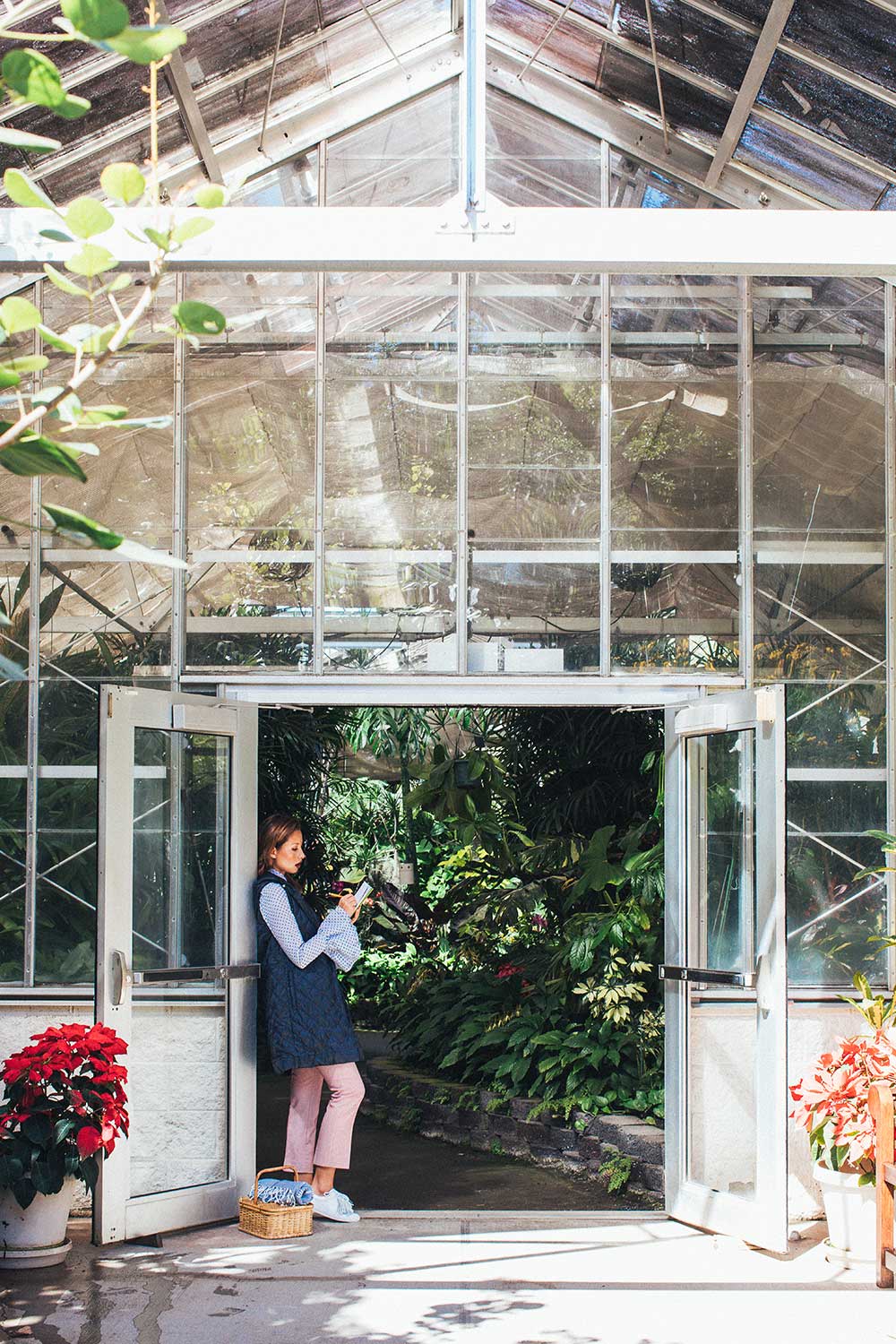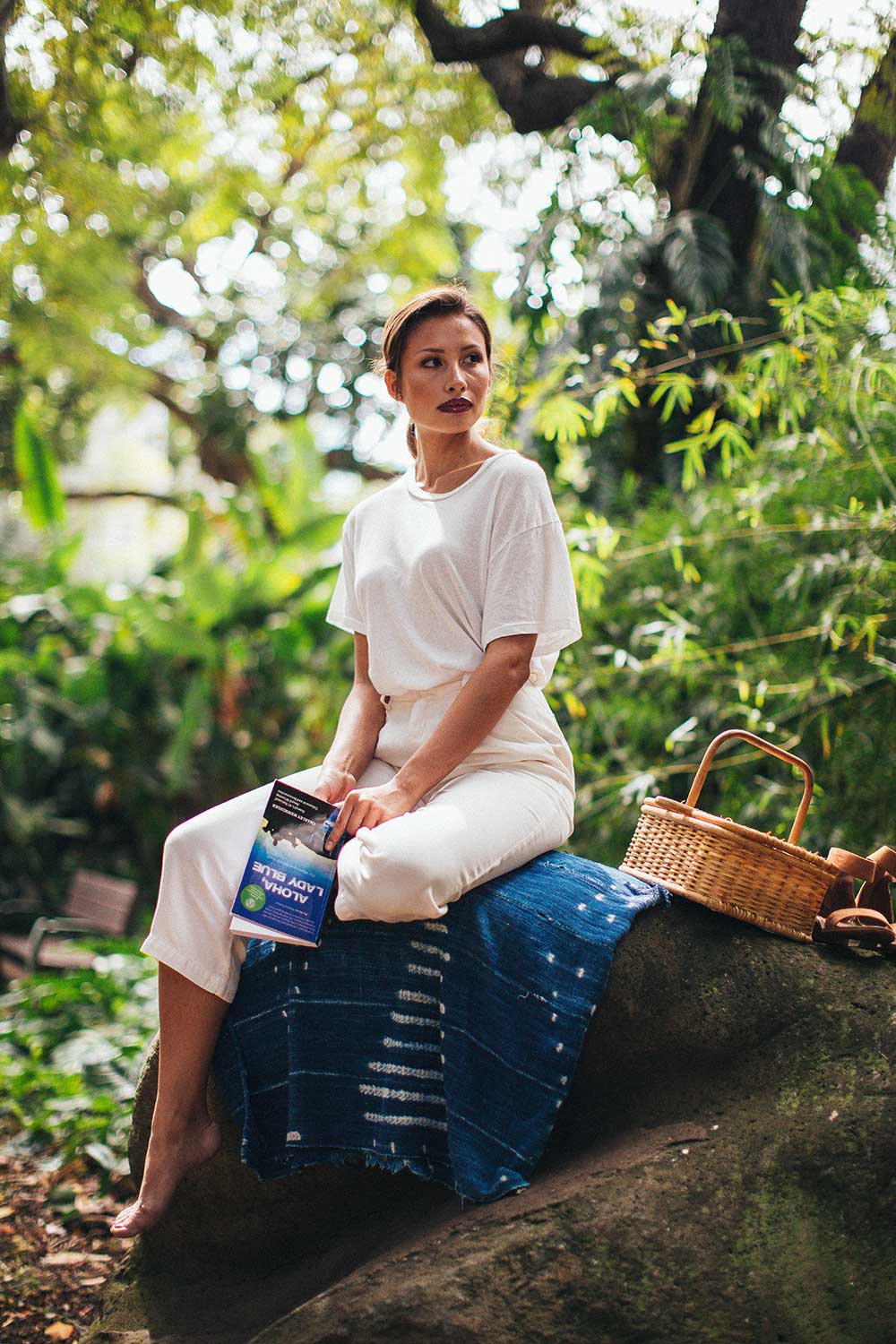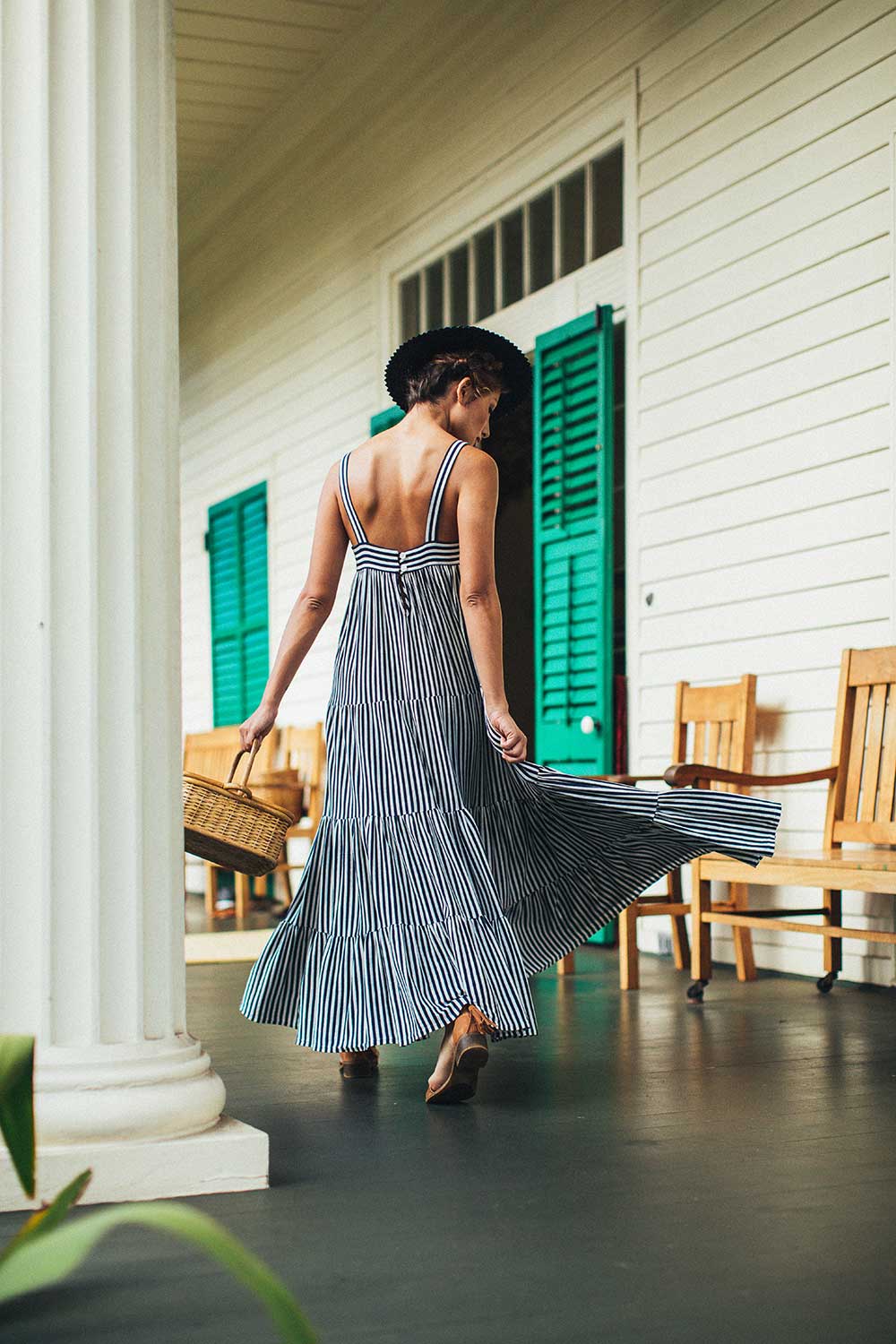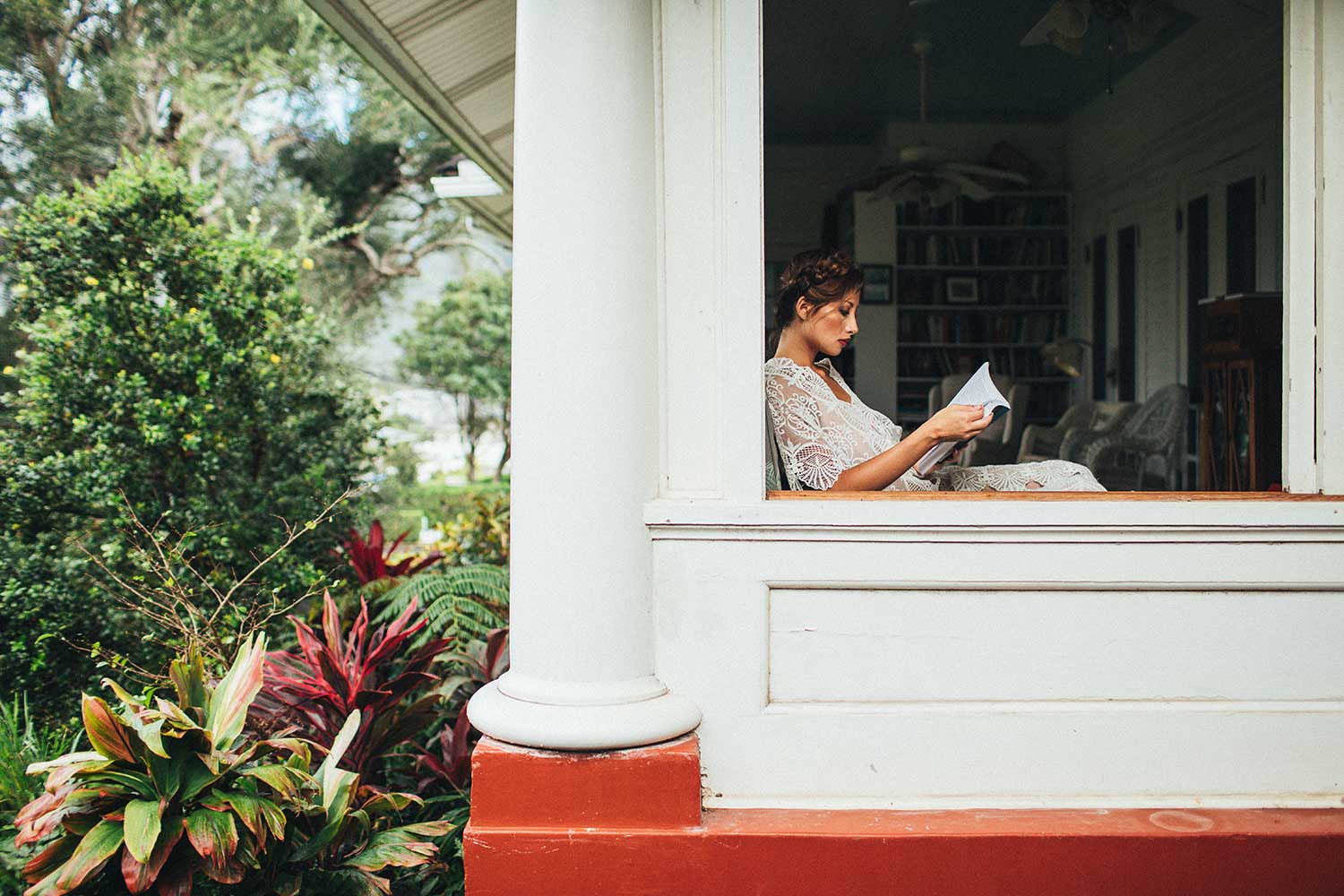Images By
Mark Kushimi
Styled By
Ara Feducia
Hair + Makeup By
HMB Salon
Modeled By
Mudra Josephson
Quiet Spaces
Pick up a good read, and escape from the bustle of the city at these serene places.
Hover/tap an image to shop
Foster Botanical Garden
This 14-acre respite in the middle of urban Honolulu is the perfect spot for getting into a good read. Relax under the shade of sprawling trees, check out the outdoor butterfly garden, or learn about an impressive collection of tropical plants in the conservatory.
Foster Botanical Garden traces its beginning to 1853, when Queen Kalama leased a small area of land to William Hillebrand, a young German doctor. A botanist as well as a physician, Hillebrand built his home in the upper terrace area of property and began planting trees.
The conservatory at Foster Botanical Garden houses a world-class collection of orchids. It even holds one of the world’s largest and most rare flowering plants, the corpse flower, which can take up to seven years to bloom.
Aloha, Lady Blue
A riveting crime novel with a good cause.
A buried family secret, a mysterious death, a damsel in distress (or so it would seem)—Aloha, Lady Blue has all the trappings of a good crime novel. Based, in part, on author Charley Memminger’s experiences as a former crime and investigative reporter at a Honolulu newspaper, Aloha, Lady Blue follows the story of Stryker McBride, a washed-up journalist seeking to uncover the mystery of what happened on Kahala Road—a road that doesn’t exist on any map.
McBride, who feels responsible for the death of one of his sources years ago, would be content to spend the rest of his days with “the gods,” as he calls them, two German shepherds named Kane and Lono, sipping Budweisers for breakfast while dry-docked on his boat, the Travis McGee. But he has little time to wallow after his help is enlisted by the beautiful Amber Kalanianaole Kam, a former Punahou classmate, who asks McBride to look into the mysterious death of her uncle Wai Lo Fat—a name that conjures up ties to the Chinese syndicate if there ever was one. What follows is an action-packed storyline that will leave you hanging on until the truth behind Kahala Road and what took place there is revealed.
A riveting whodunit for those familiar with Hawai‘i, as well as those who aren’t, Aloha, Lady Blue delivers visual soliloquies that take readers past sweeping taro fields and heart-stopping mountain ranges, while incorporating factual elements with panache. Readers get a quick lesson in Hawaiian history, from Captain Cook—“whacked” after Hawaiians realized he wasn’t the manifestation of the god Lono—to Chinese plantation workers, for whom McBride tries to imagine “how bad life in your own country would have to suck before it seemed like a good idea to sail ten thousand miles to work in a strange foreign land under the hot tropical sun.”
The book was originally published by St. Martin’s Press in 2013 and was released in paperback form in 2015. In a tribute to the book’s canine characters, Memminger has pledged to donate all author royalties from its book sales to the Hawaiian Humane Society. “I realized what an important job the Hawaiian Humane Society has, not just putting dogs and cats up for adoption, but taking care of all the animals in its care,” writes Memminger, who first became interested in helping the Humane Society after adopting his family’s first pet, Boomer, a poi dog with a strong hint of border collie, in 1995.—Lisa Yamada-Son
Aloha, Lady Blue is available in bookstores around Hawai‘i, as well as on Amazon and bookshawaii.net.
Citizen Steele
In this novella by Peter Shaindlin, published by Deuxmers (read more on page 32), reclusive attorney Richard Jason Steele probes questions of his existence after committing a violent crime and facing execution. In his growing anguish, Steele examines the work of French author Michel Houellebecq: “Not everything can be explained. There is thought and so there is reason, and so there is hope but inevitably, despair. An inanimate idea would be the perfect expression of infinity as a conscious state of mind … a parallax portal by which one could stop living momentarily in organic terms, perhaps long enough to exchange ideas with God.”
The Value of Hawai‘i 2
A series of essays encourages dialogue issues in Hawai‘i that will affect future generations.
Though it was published in 2014, The Value of Hawai‘i 2: Ancestral Roots, Oceanic Visions, co-edited by Aiko Yamashiro and Noelani Goodyear-Ka‘ōpua, remains relevant in prompting dialogue on some of Hawai‘i’s most pressing ecological and social issues.
The follow-up to The Value of Hawai‘i: Knowing the Past, Shaping the Future (which was published by University of Hawai‘i Press in 2010), the book is compiled of a series of essays written by 40 different authors. Canoe captain and educator Bonnie Kahape‘a Tanner tells sea tales about the voyaging canoe Kānehūnāmoku and the lessons it imparts to keiki. Jeffrey Tangonan Acido discusses the capacity of faith as a tool of equality in the Philippines and urban Honolulu.
“We know that our children and grandchildren will carry the full weight of ecological and social problems, such as climate change, growing economic inequality, and erosion of public safety net services, which have been left to us to address,” write Yamashiro and Goodyear- Ka‘ōpua. The way they address those issues is through stories of hope, work, and joy.—sonny ganaden
The Value of Hawai‘i 2: Ancestral Roots, Oceanic Visions is available at uhpress.hawaii.edu.
Mānoa Valley
Although the lush neighborhood of Mānoa is most commonly known as being home to the University of Hawai‘i, it is also filled with a high concentration of historic homes listed on the National Register of Historic Places. Once a year, Mālama Mānoa holds walking tours of some of the area’s historic homes. The tour includes at least eight interior visits along a 2-mile route of more than 60 homes built in the 1920s and ’30s. For more information, visit malamaomanoa.org.
Barbarian Days
A Pulitzer Prize-winning autobiography.
It seems odd at first that William Finnegan, when writing his memoir, chose to center it upon surfing. Finnegan’s work as a war correspondent flung him to fascinating and perilous corners of the world. Yet, Barbarian Days: A Surfing Life, which won a Pulitzer Prize in 2016, is about his experience in—and connection to—water.
For Finnegan, the dedicated study of one simple thing—the way a body and a board move across the face of a wave—lends itself to the study of much more complicated, even maddening, things: wars, apartheid, uprisings, human nature, and above all else, change.
Born in California, Finnegan’s story begins with his family’s relocation to Hawai‘i in 1966. At age 13, beneath the shadow of O‘ahu’s Diamond Head Crater, he began a lifelong surfing practice. In the mornings, before catching the bus to school, he would walk down the path fronting his house to surf Cliffs, where he’d hone his skills while studying the older, better, cooler local guys in the line-up. His recollection is enough to trigger a lingering nostalgia even in those born in an entirely different era of Hawai‘i’s history.
Finnegan left Hawai‘i with his family and traveled the world, first as a young man in search of undiscovered waves, then as a reporter, and later, as a seasoned surfer on holiday from his stable, professional life. Over the course of this time, surfing became an industry; breaks were commercialized, empty line- ups filled, and quiet towns and villages developed into tourist destinations. A pattern emerged. As much as anyone else, Finnegan was altering the very landscape he longed for.
In one particularly moving passage, Finnegan mourns the death of a beautiful break in Madeira, off the coast of Portugal, ruined by the construction of a seaside roadway along the town of Jardim do Mar. “Beyond the loss or gain,” Finnegan writes, “I found these sudden changes to established surf spots profoundly unsettling.” As he ages, the author accedes that even his body has begun to change without his permission. Still, there is solace in an expertly ridden wave, a hollow barrel, and the constant movement of the sea. For all its painstakingly detailed accounts of encountering surf breaks in Fiji, South Africa, or Honolua Bay on Maui, Barbarian Days is about much more than just surfing. It’s about a life molded by time, physics, and the force of deep-water energy crashing into land.—tina grandinetti
Available online and wherever books are sold.
Kilometer 99
Find escape in the waves of El Salvador
It starts with a near perfect barrel ride at a Salvadoran surf break, closed out in a heap of whitewash and a heavy dose of foreshadowing. With short chapters that pile on quickly and often end with a cliffhanger, Kilometer 99 is a fast-paced read about a young Peace Corps engineer from Honolulu. The no-fuss writing suggests a charming beach read; however, it is no delightful traveler’s escape to El Salvador, no feel-good Eat, Pray, Love. Local writer Tyler McMahon’s prose instead swiftly builds the setup for an adventure that tragically devolves shortly after the scene is set.
The plot centers on Malia, nicknamed “Chinita,” a Peace Corps volunteer who headed to El Salvador for a chance to see the world. Instead, she finds herself faced with widespread destruction after an earthquake racks the country, her nearly completed water project destroyed. She and her boyfriend decide to cash out and take a surf trip around South America, only to get waylaid by a mysterious bumbling foreigner who pulls them into increasingly shady deals.
It’s in McMahon’s descriptions of the surf sessions, the vividness of El Salvador, and the intense moments when things get progressively worse that McMahon’s writing shines. When a second earthquake hits El Salvador after Malia’s passport and money have been stolen, she picks up a surfboard and heads for the ocean. “I realize then, or remember perhaps, that the surfer’s idea of perfection is different from everyone else’s,” Malia narrates. “It isn’t abstract or inscrutable, some shadow on the wall of a cave. We know what it feels like—perfection—how it looks and the sound it makes.”
McMahon, a professor of English at Hawai‘i Pacific University who was a Peace Corps volunteer in El Salvador, creates an engaging narrative spiced with convincing details, from local Salvadoran food and architecture to the types of characters found in a seaside town awash in cocaine. In this quick read, El Salvador flashes by the window. Kilometer 99 is more destination than escape—it’s a novel, after all—and one worth visiting.—anna harmon
Kilometer 99 is available online and wherever books are sold.
Foster Botanical Garden
180 N. Vineyard Blvd.
Chinatown
Queen Emma Summer Palace
2913 Pali Hwy.
Honolulu
Images By
Mark Kushimi
Styled By
Ara Feducia
Hair + Makeup By
HMB Salon
Modeled By
Mudra Josephson
Quiet Spaces
Pick up a good read, and escape from the bustle of the city at these serene places.
Hover/tap an image to shop
Foster Botanical Garden
This 14-acre respite in the middle of urban Honolulu is the perfect spot for getting into a good read. Relax under the shade of sprawling trees, check out the outdoor butterfly garden, or learn about an impressive collection of tropical plants in the conservatory.
Foster Botanical Garden traces its beginning to 1853, when Queen Kalama leased a small area of land to William Hillebrand, a young German doctor. A botanist as well as a physician, Hillebrand built his home in the upper terrace area of property and began planting trees.
The conservatory at Foster Botanical Garden houses a world-class collection of orchids. It even holds one of the world’s largest and most rare flowering plants, the corpse flower, which can take up to seven years to bloom.
Aloha, Lady Blue
A riveting crime novel with a good cause.
A buried family secret, a mysterious death, a damsel in distress (or so it would seem)—Aloha, Lady Blue has all the trappings of a good crime novel. Based, in part, on author Charley Memminger’s experiences as a former crime and investigative reporter at a Honolulu newspaper, Aloha, Lady Blue follows the story of Stryker McBride, a washed-up journalist seeking to uncover the mystery of what happened on Kahala Road—a road that doesn’t exist on any map.
McBride, who feels responsible for the death of one of his sources years ago, would be content to spend the rest of his days with “the gods,” as he calls them, two German shepherds named Kane and Lono, sipping Budweisers for breakfast while dry-docked on his boat, the Travis McGee. But he has little time to wallow after his help is enlisted by the beautiful Amber Kalanianaole Kam, a former Punahou classmate, who asks McBride to look into the mysterious death of her uncle Wai Lo Fat—a name that conjures up ties to the Chinese syndicate if there ever was one. What follows is an action-packed storyline that will leave you hanging on until the truth behind Kahala Road and what took place there is revealed.
A riveting whodunit for those familiar with Hawai‘i, as well as those who aren’t, Aloha, Lady Blue delivers visual soliloquies that take readers past sweeping taro fields and heart-stopping mountain ranges, while incorporating factual elements with panache. Readers get a quick lesson in Hawaiian history, from Captain Cook—“whacked” after Hawaiians realized he wasn’t the manifestation of the god Lono—to Chinese plantation workers, for whom McBride tries to imagine “how bad life in your own country would have to suck before it seemed like a good idea to sail ten thousand miles to work in a strange foreign land under the hot tropical sun.”
The book was originally published by St. Martin’s Press in 2013 and was released in paperback form in 2015. In a tribute to the book’s canine characters, Memminger has pledged to donate all author royalties from its book sales to the Hawaiian Humane Society. “I realized what an important job the Hawaiian Humane Society has, not just putting dogs and cats up for adoption, but taking care of all the animals in its care,” writes Memminger, who first became interested in helping the Humane Society after adopting his family’s first pet, Boomer, a poi dog with a strong hint of border collie, in 1995.—Lisa Yamada-Son
Aloha, Lady Blue is available in bookstores around Hawai‘i, as well as on Amazon and bookshawaii.net.
Citizen Steele
In this novella by Peter Shaindlin, published by Deuxmers (read more on page 32), reclusive attorney Richard Jason Steele probes questions of his existence after committing a violent crime and facing execution. In his growing anguish, Steele examines the work of French author Michel Houellebecq: “Not everything can be explained. There is thought and so there is reason, and so there is hope but inevitably, despair. An inanimate idea would be the perfect expression of infinity as a conscious state of mind … a parallax portal by which one could stop living momentarily in organic terms, perhaps long enough to exchange ideas with God.”
The Value of Hawai‘i 2
A series of essays encourages dialogue issues in Hawai‘i that will affect future generations.
Though it was published in 2014, The Value of Hawai‘i 2: Ancestral Roots, Oceanic Visions, co-edited by Aiko Yamashiro and Noelani Goodyear-Ka‘ōpua, remains relevant in prompting dialogue on some of Hawai‘i’s most pressing ecological and social issues.
The follow-up to The Value of Hawai‘i: Knowing the Past, Shaping the Future (which was published by University of Hawai‘i Press in 2010), the book is compiled of a series of essays written by 40 different authors. Canoe captain and educator Bonnie Kahape‘a Tanner tells sea tales about the voyaging canoe Kānehūnāmoku and the lessons it imparts to keiki. Jeffrey Tangonan Acido discusses the capacity of faith as a tool of equality in the Philippines and urban Honolulu.
“We know that our children and grandchildren will carry the full weight of ecological and social problems, such as climate change, growing economic inequality, and erosion of public safety net services, which have been left to us to address,” write Yamashiro and Goodyear- Ka‘ōpua. The way they address those issues is through stories of hope, work, and joy.—sonny ganaden
The Value of Hawai‘i 2: Ancestral Roots, Oceanic Visions is available at uhpress.hawaii.edu.
Mānoa Valley
Although the lush neighborhood of Mānoa is most commonly known as being home to the University of Hawai‘i, it is also filled with a high concentration of historic homes listed on the National Register of Historic Places. Once a year, Mālama Mānoa holds walking tours of some of the area’s historic homes. The tour includes at least eight interior visits along a 2-mile route of more than 60 homes built in the 1920s and ’30s. For more information, visit malamaomanoa.org.
Barbarian Days
A Pulitzer Prize-winning autobiography.
It seems odd at first that William Finnegan, when writing his memoir, chose to center it upon surfing. Finnegan’s work as a war correspondent flung him to fascinating and perilous corners of the world. Yet, Barbarian Days: A Surfing Life, which won a Pulitzer Prize in 2016, is about his experience in—and connection to—water.
For Finnegan, the dedicated study of one simple thing—the way a body and a board move across the face of a wave—lends itself to the study of much more complicated, even maddening, things: wars, apartheid, uprisings, human nature, and above all else, change.
Born in California, Finnegan’s story begins with his family’s relocation to Hawai‘i in 1966. At age 13, beneath the shadow of O‘ahu’s Diamond Head Crater, he began a lifelong surfing practice. In the mornings, before catching the bus to school, he would walk down the path fronting his house to surf Cliffs, where he’d hone his skills while studying the older, better, cooler local guys in the line-up. His recollection is enough to trigger a lingering nostalgia even in those born in an entirely different era of Hawai‘i’s history.
Finnegan left Hawai‘i with his family and traveled the world, first as a young man in search of undiscovered waves, then as a reporter, and later, as a seasoned surfer on holiday from his stable, professional life. Over the course of this time, surfing became an industry; breaks were commercialized, empty line- ups filled, and quiet towns and villages developed into tourist destinations. A pattern emerged. As much as anyone else, Finnegan was altering the very landscape he longed for.
In one particularly moving passage, Finnegan mourns the death of a beautiful break in Madeira, off the coast of Portugal, ruined by the construction of a seaside roadway along the town of Jardim do Mar. “Beyond the loss or gain,” Finnegan writes, “I found these sudden changes to established surf spots profoundly unsettling.” As he ages, the author accedes that even his body has begun to change without his permission. Still, there is solace in an expertly ridden wave, a hollow barrel, and the constant movement of the sea. For all its painstakingly detailed accounts of encountering surf breaks in Fiji, South Africa, or Honolua Bay on Maui, Barbarian Days is about much more than just surfing. It’s about a life molded by time, physics, and the force of deep-water energy crashing into land.—tina grandinetti
Available online and wherever books are sold.
Kilometer 99
Find escape in the waves of El Salvador
It starts with a near perfect barrel ride at a Salvadoran surf break, closed out in a heap of whitewash and a heavy dose of foreshadowing. With short chapters that pile on quickly and often end with a cliffhanger, Kilometer 99 is a fast-paced read about a young Peace Corps engineer from Honolulu. The no-fuss writing suggests a charming beach read; however, it is no delightful traveler’s escape to El Salvador, no feel-good Eat, Pray, Love. Local writer Tyler McMahon’s prose instead swiftly builds the setup for an adventure that tragically devolves shortly after the scene is set.
The plot centers on Malia, nicknamed “Chinita,” a Peace Corps volunteer who headed to El Salvador for a chance to see the world. Instead, she finds herself faced with widespread destruction after an earthquake racks the country, her nearly completed water project destroyed. She and her boyfriend decide to cash out and take a surf trip around South America, only to get waylaid by a mysterious bumbling foreigner who pulls them into increasingly shady deals.
It’s in McMahon’s descriptions of the surf sessions, the vividness of El Salvador, and the intense moments when things get progressively worse that McMahon’s writing shines. When a second earthquake hits El Salvador after Malia’s passport and money have been stolen, she picks up a surfboard and heads for the ocean. “I realize then, or remember perhaps, that the surfer’s idea of perfection is different from everyone else’s,” Malia narrates. “It isn’t abstract or inscrutable, some shadow on the wall of a cave. We know what it feels like—perfection—how it looks and the sound it makes.”
McMahon, a professor of English at Hawai‘i Pacific University who was a Peace Corps volunteer in El Salvador, creates an engaging narrative spiced with convincing details, from local Salvadoran food and architecture to the types of characters found in a seaside town awash in cocaine. In this quick read, El Salvador flashes by the window. Kilometer 99 is more destination than escape—it’s a novel, after all—and one worth visiting.—anna harmon
Kilometer 99 is available online and wherever books are sold.













































Share: